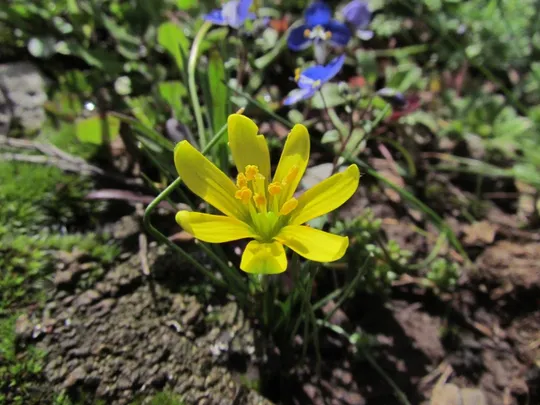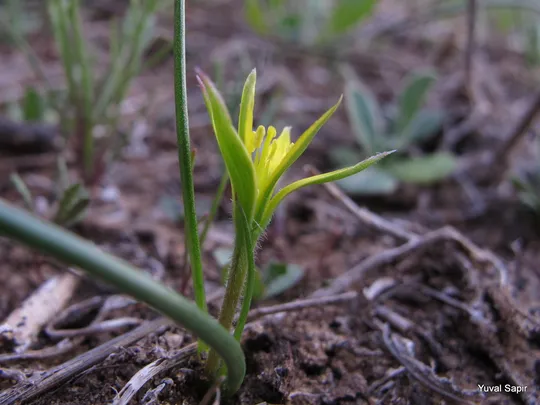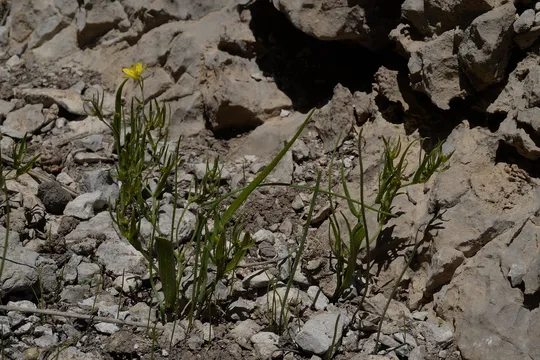Gagea libanotica
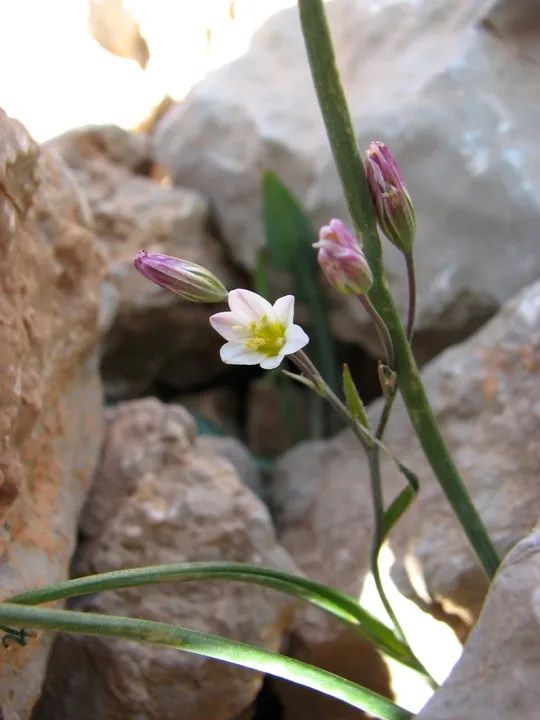
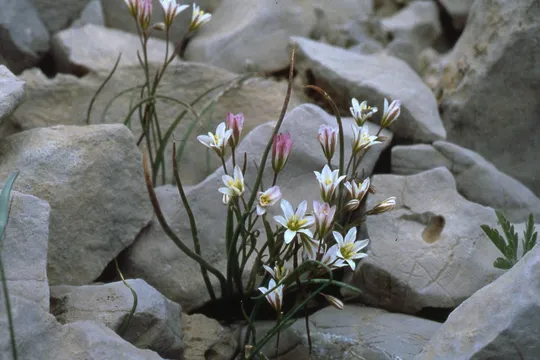
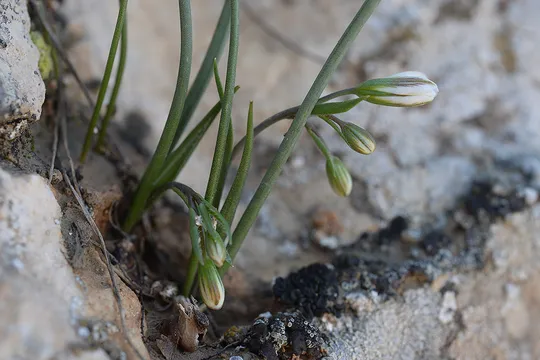
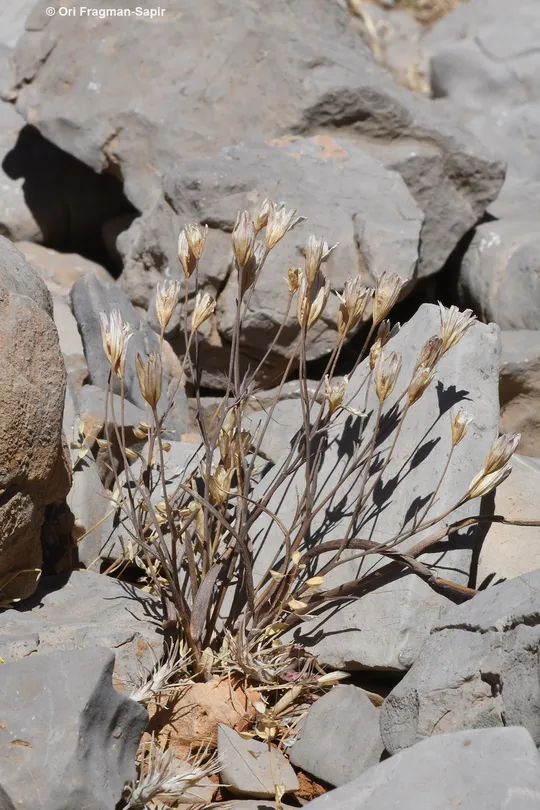
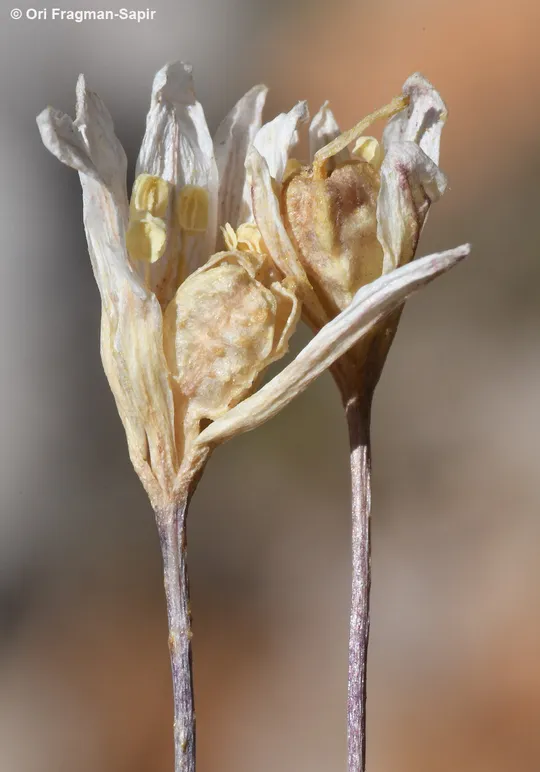
Gagea libanotica grows in only one
region in Israel, the Negev Highlands, where it was first discovered by Ofer
Cohen in 1990. In this area, it was found and documented at two sites – the Ramon
Makhtesh cliff and Ma'ale Arod, at an altitude of 900 to 1000 meters. The
species is estimated to grow at a total of four sites between Ma'ale Arod to Hemet
Cistern. Post recorded G. libanotica from Jerusalem, but the herbarium
sheet was not found nor was the plant located again in the field. Its presence
in the Judean Mountains is doubtful, particularly as the flowers of G. chlorantha
that is common in Jerusalem, whiten slightly when
wilting and are similar to the flowers of G. libanotica. The plant is found
on the Hermon at many sites in the Tragacanth zone at altitudes above 1750 m, outside
the scope of this book.
Rocky slopes and soil
pockets in hard limestone, at the foot of cliffs in the high steppe plant
community of Artemisia sieberi and among montane tragacanth vegetation.
Gagea libanotica was previously
assigned to genus Lloydia, which contains 12 species, all found in the
temperate zone. Greuter (1970) included the species in the genus Gagea. It
seems that in the Middle East Gagea constitutes a clear monophyletic
group, distinct from other Lloydia genus groups (by the color of its flowers
and the shape of the perianth). However, the comprehensive molecular study of
Zarrei et. al. (2009) shows clearly that the Lloydia species of are not
of separate origin, and some, (mainly G. libanotica) are scattered throughout
the molecular cladistic tree between the yellow–flowered Gagea species.
In other words – the Gagea genus in the narrow sense and the Lloydia
genus have a common lineage. This study supports the inclusion of various Lloydia
species in the genus Gagea and agrees with the fact that there are
transition species in the eastern Himalayas between what was formally described
as the genus Lloydia and the genus Gagea.
G. libanotica belongs to the
group of plants growing in the arid tragacanth zone of the Middle East. Its recent discovery on the Negev Highlands is
of great biogeographical significance: it implies that in the not so distant
past (about 16,000 years ago) when the climate in our region was much colder
and humid, tragacanth vegetation penetrated southwards to the Jerusalem Hills and the
Negev Highlands up to southern Sinai. As the climate warmed (and became dryer)
in the Holocene, many of plants belonging to the tragacanth group became extinct and
survived only in high desert mountains and at the edges of the Mediterranean region.
Representatives of this group in the Negev Highlands include Tulipa
polychroma, Rochelia disperma, Rheum palaestinium,
Atraphaxis
spinosa and
others.
•
The existence of
Gagea libanotica in Israel, in a single region – the Negev Highlands – is
known only since 1990. Post's data from Jerusalem is doubtful and does not to
provide evidence of any changes in the number of regions over time.
•
The number of G.
libanotica sites in the Negev Highlands is very small, two are certain or
possible four according to estimates, but there is no continuous information on
the stability or change in the number of sites. However, on Mount Hermon many
sites are known.
•
In the Negev
Highlands the known G. libanotica populations are small and occupy very
small areas. The population found by Ofer Cohen numbered 30 plants in an area
of one sq. meter.
•
The Negev
Highlands sites are not threatened by anthropogenic activity, although the
small population sizes of G. libanotica increase the risk of extinction for
genetic and demographic reasons. The species is apparently not endangered on
Mount Hermon.
•
G. libanotica
is protected in the Negev Highlands Reserve.
•
G. libanotica
is endemic to Lebanon, Jordan, Mount Hermon and the Negev Highlands. The Negev
Highlands population is isolated and fragmented and it is an extreme marginal
population that requires preservation and taxonomical research.
•
The existence of
Gagea libanotica in Israel, in a single region – the Negev Highlands – is
known only since 1990. Post's data from Jerusalem is doubtful and does not to
provide evidence of any changes in the number of regions over time.
•
The number of G.
libanotica sites in the Negev Highlands is very small, two are certain or
possible four according to estimates, but there is no continuous information on
the stability or change in the number of sites. However, on Mount Hermon many
sites are known.
•
In the Negev
Highlands the known G. libanotica populations are small and occupy very
small areas. The population found by Ofer Cohen numbered 30 plants in an area
of one sq. meter.
•
The Negev
Highlands sites are not threatened by anthropogenic activity, although the
small population sizes of G. libanotica increase the risk of extinction for
genetic and demographic reasons. The species is apparently not endangered on
Mount Hermon.
•
G. libanotica
is protected in the Negev Highlands Reserve.
•
G. libanotica
is endemic to Lebanon, Jordan, Mount Hermon and the Negev Highlands. The Negev
Highlands population is isolated and fragmented and it is an extreme marginal
population that requires preservation and taxonomical research.
Israel, Jordan,
Syria and Lebanon.
Gagea libanotica
is a small
geophyte, very rare in Israel, which grows on a small number of sites in the
Negev Highlands. It is more common on the Hermon. The presence of plant in the
Negev Highlands has a biogeographic significance because it provides evidence
on the connection between the Mount Hermon vegetation and the vegetation in
high places in the Negev Highlands. Apparently, the major risk to populations
in the Negev Highlands is genetic and demographic. The sparse information
available on these populations requires tracking and monitoring.
ראה רשימת הספרות הכללית.
Current Occupancy Map
| 1000 squre meter pixel | 5000 squre meter pixel | 10000 squre meter pixel | |
|---|---|---|---|
| number of observations | 0 | 0 | 0 |
| in total pixels | 0 | 0 | 0 |
| Family | Liliaceae |
| Classification | On the endangered species list |
| Ecosystem | Desert Mountains and Tragacanthic |
| Chorotype | Irano - Turanian |
| Conservation Site | Ramon Crater cliffs in the area of Mount Ramon |
| Rarity |
1
5
6
|
|---|---|
| Vulnerability |
0
0
4
|
| Attractiveness |
0
1
4
|
| Endemism |
0
1
4
|
| Red number |
1
4.2
10
|
| Peripherality | N |
| IUCN category | DD EW EX LC CR EN VU NT |
| Threat Definition according to the red book | Endangered |
 Based on:
Based on:
